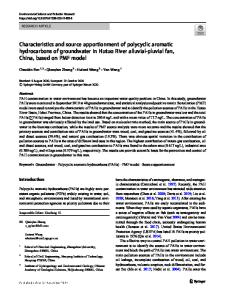Spatiotemporal distribution and source variations of hydrocarbons in surface sediments from the Pearl River Estuary, Sou
- PDF / 985,664 Bytes
- 13 Pages / 595.276 x 790.866 pts Page_size
- 73 Downloads / 357 Views
SEDIMENTS, SEC 1 • SEDIMENT QUALITY AND IMPACT ASSESSMENT • RESEARCH ARTICLE
Spatiotemporal distribution and source variations of hydrocarbons in surface sediments from the Pearl River Estuary, Southern China Yanzhen Zhang 1 & Yongge Sun 1 & Ben Liu 1,2 & Yuntao Wang 3 & Wei Xie 4,5 & Peng Wang 6 & Chuanlun Zhang 7 & Ding He 1,3 Received: 20 April 2020 / Accepted: 13 September 2020 # Springer-Verlag GmbH Germany, part of Springer Nature 2020
Abstract Purpose Variations in hydrocarbon composition and concentration are essential for the assessment of its source and environmental health in estuarine environments. This study aims to reveal the spatial and temporal distribution of multiple hydrocarbons in surface sediments of the Pearl River Estuary, and to further determine various sources of these hydrocarbons. Materials and methods Surface sediments were taken monthly from four sites along a spatial transect from the Pearl River Estuary in a whole year by using a gravitational bottom sampler. A series of bulk parameters including the grain size, total organic carbon content, and total nitrogen content were measured. Hydrocarbons in sediments were extracted and analyzed by the gas chromatography-mass spectrometry. Results and discussion The abundances of higher plants and phytoplankton-derived n-alkanes, petrogenically derived pristane, phytane, hopanes, and steranes with geological configuration, and anthropogenically derived hydrocarbons, including linear alkylbenzenes and polycyclic aromatic hydrocarbons all showed decreasing trends towards the coastal ocean. In contrast, the diatom-derived C25 highly branched isoprenoids increased towards saline sites. Monthly fluctuations of aliphatic and aromatic hydrocarbons at the estuarine mouth were smaller than the upstream freshwater sites, where high monthly variation (up to fivefold) was observed for most of the hydrocarbons detected. Conclusions This study showed substantial monthly and spatial variations of hydrocarbons in the surface sediments of the Pearl River Estuary. Distribution and composition of sedimentary hydrocarbons indicate mainly anthropogenic inputs (e.g., petroleum residues and synthetic detergents) and terrestrially higher plants, followed by aquatic inputs. Keywords Surface sediments . Source . Hydrocarbons . Pearl River Estuary . Biomarkers
Responsible editor: Nives Ogrinc Electronic supplementary material The online version of this article (https://doi.org/10.1007/s11368-020-02783-0) contains supplementary material, which is available to authorized users. * Ding He [email protected]
4
Department of Marine Sciences, Sun Yat-Sen University, Zhuhai, China
1
Key Laboratory of Geoscience Big Data and Deep Resource of Zhejiang Province, School of Earth Sciences, Zhejiang University, Hangzhou, China
5
Southern Marine Science and Engineering Guangdong Laboratory (Zhuhai), Zhuhai 519082, China
2
Guangzhou Institute of Geochemistry, Chinese Academy of Sciences, Guangzhou, China
6
School of Ocean and Earth Sciences, Tongji University, Shanghai, Ch
Data Loading...











